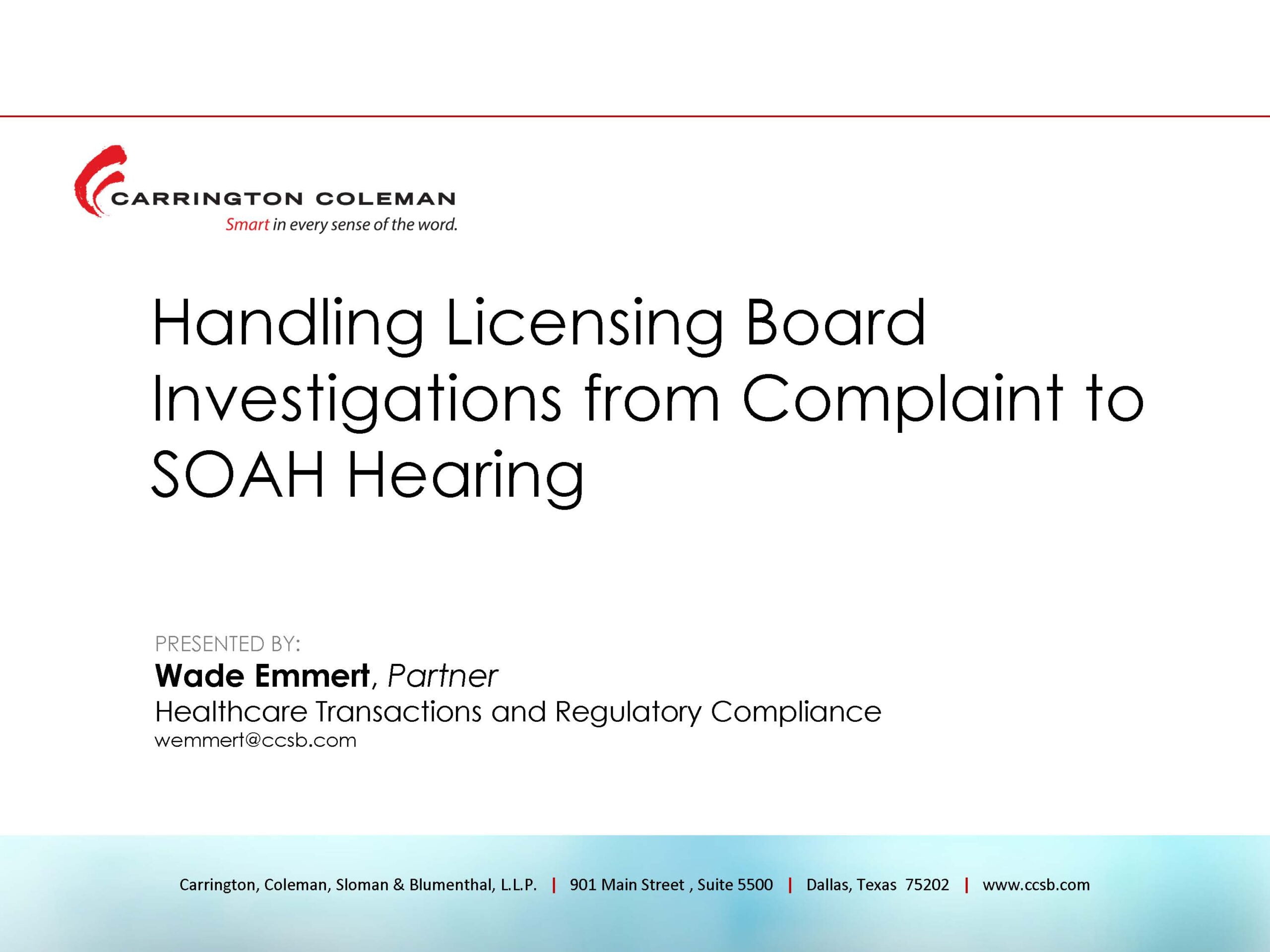This is a four-part series on Handling Licensing Board Investigations from Complaint to SOAH Hearing. In preparation for this series, I talked to several of the staff attorneys and investigators for the Texas Medical Board, the Board of Nursing, and the Board of Chiropractic Examiners. I asked them what advice they would give lawyers practicing before their boards. Some of the suggestions throughout this series come from the staff attorneys and others come from trial and error on my part through years of representing clients before these boards.
The series will present issues associated with the phases of the investigation and resolution:
- Part I – What’s Going On?
- Part II – The Investigation
- Part III – The Informal Settlement Conference (ISC)
- Part IV – The SOAH Hearing
The purpose of this series is to give licensees and their attorneys a greater understanding of the complaint and investigation process. Of course, each board is different and each investigation is driven by the issues and personalities involved. Licensees and their attorneys are encouraged to understand the rules and processes applicable to the relevant board. Further materials about the complaint, investigation, and hearing process are available on board websites.
Part II of this series explores the investigation and the discovery issues involved.
The Big Picture
The investigation process starts with a complaint. The complaint goes through a preliminary evaluation process and may be dismissed. If it passes this preliminary evaluation, the board will open a formal investigation during which a board investigator will gather information about the case, including medical records and witness statements.
When the investigation is complete, the information will be presented to a review committee. The committee will either refer the matter to litigation or be dismissed. The terminology of “referral to litigation” is most often used by the Texas Medical Board and simply means that the matter is assigned to one of their staff attorney for further handling, with the assistance of the investigator.
At this point, the matter could still be dismissed, but most likely will proceed to some type of Informal Settlement Conference (ISC) or proposed Agreed order. If it’s not resolved at this more informal stage, the matter goes to the State Office of Administrative Hearings (SOAH) for a more formal proceeding.
There is a big difference in terms of tone and focus from the complaint and the informal settlement conference, and the SOAH hearing. The first part of the investigation is more of an informal process. A SOAH proceeding has a much different tone, similar to a lawsuit. A judge will preside, without a jury, listen to testimony, and rule on evidence. After the SOAH proceeding, the judge will issue a ruling with findings of facts and conclusions of law. The licensing board will consider the ruling and take appropriate action.
The Complaint
Having explained the process in general, let’s get into the details of each step.
Complaints can be initiated in several ways. There is an online form or a written complaint form that can be downloaded. There is a complaint hotline that patients can call. Most complaints come from patients, but they can be initiated by the licensee’s fellow practitioners. Practitioners are required to report their peers if they feel like their conduct is a threat to public safety. Finally, complaints can be initiated by the board itself. This most often occurs if the licensee gets arrested or charged for a crime – e.g. driving while intoxicated.
Once a complaint has been initiated with the Texas Medical Board, there are no takebacks. The patient cannot withdraw it if they change their mind. That is not the case with the chiropractic board or the board of nursing, where they can be withdrawn. At some point, the ability to withdraw a complaint becomes moot because the complaint has progressed into the formal investigation phase where the investigator has likely have found other issues and does not the complaint to continue the process.
The complainant’s identity is confidential, with certain rare exceptions. But complaints cannot be anonymous. Anonymous complaints are dismissed without further action. See 22 Tex. Admin. § 178.4.
The Preliminary Evaluation
Once the complaint is filed, an investigator will be assigned to the file and they will communicate with the complainant as part of their preliminary evaluation.
The preliminary evaluation is not a detailed review of all the allegations and supporting facts. It is a narrow evaluation to determine if the licensing board has jurisdiction over the complaint.
The preliminary evaluation must be conducted within 45 days. Within 45 days, the board will know whether they have jurisdiction over the matter. It has been my experience that if the board determines they have jurisdiction, the matter will most likely be referred to a staff attorney to direct the handling in conjunction with an investigator to gather facts.
At the beginning of the preliminary evaluation, the licensee is notified and allowed to respond.
It is difficult for the licensee to adequately respond. While the licensee is told generally about the nature of the complaint, it is typically vague.

This is a letter from one of my cases before the Texas Medical Board. You will note that the letter includes general statutory allegations such as unlawful advertising, practice, inconsistent with health and health and welfare, and unprofessional conduct, which you will see in every case involving non-therapeutic prescribing or treatment.
That gives us the gist of the complaint, but it does not tell us much about the context. At least we know it has something to do with advertising. So in this case that’s all the information we received when they invited the practitioner to respond.
In hindsight, the complaint involved advertising IV infusions that could allegedly prevent COVID. This was long before the vaccinations existed. The licensee was trying to imply that her vitamin-enriched solutions would make you more healthy which would make you less susceptible to contracting COVID. The medical board was not pleased.
The challenge is how do you respond to such vague allegations?
This is where licensees typically make a series of mistakes. They fail to get a lawyer involved and casually send responses to the board, usually by email, and often with a tone of informality.
It is important to understand that the scope of the investigation is not limited by the complaint. If the board finds other potential violations, they can and will broaden their investigation. Neither the practitioner nor the investigator knows what information is going to be relevant.
In my view, the best course of action is to respond very narrowly and succinctly. You will have plenty of time as you go through this process to respond further.
If you are counsel representing a practitioner, it is also a good idea to call the investigator to try to get more information about the allegations. The chiropractic board, for example, has a policy of trying to give as much information to the licensee as possible while respecting the bounds of confidentiality. Not all boards may be quite as forthcoming. It depends on the board and the investigator, but it does not hurt to ask. Some boards want to facilitate this communication. They want to get as substantive of response as they can, so they can make that preliminary evaluation.
Is the Complaint Jurisdictional?
The key question in the preliminary evaluation is whether the complaint is jurisdictional. What does that mean?
The issue is whether this particular licensing board has the authority to handle the complaint and impose a penalty on the practitioner if warranted. The first question then is whether the complaint is about one of the board’s licensees.
This is not always a simple issue. Patients do not always know who the provider is. In some practices, the patient may never see the doctor. Perhaps the patient is treated by a nurse practitioner or physician assistant. The physician may not be on-site. Supervision is accomplished by reviewing samples of charts sometime after the care is provided. Not understanding the relationship, the patient may complain to the medical board about the nurse practitioner, or they may complain to the nursing board about the physician. In the case of a med spa, where a physician acts as the medical director, the patient may complain to the nursing board because they talked to a nurse practitioner.
Providers should be careful about blurring the lines about who is responsible for the care. If your client is in one of these multidisciplinary practices, make sure the website is clear about who is providing what care.
The next question is whether the complaint if taken as true states a violation of the board statute or board rule. Complaints can be dismissed because the subject of the complaint is not a violation. With that said, almost any complaint can constitute “unprofessional conduct” depending on the context. Many of the board rules are written to include a broad range of conduct.
If there is no jurisdiction, the board will dismiss the complaint. Depending on the allegations, the board may also refer the matter to the appropriate licensing board or state agency.
One exception is the Texas Medical Board. If they do not have jurisdiction over the practitioner, but feel like the practitioner is practicing medicine without a license, they will issue Cease and Desist letter.

Here’s an example of one such letter. This was sent to a nurse practitioner. The medical board felt like she was practicing beyond the scope of her delegation.
The letter is a notice of a hearing inviting the nurse to explain why a Cease and Desist Order should not be issued. The burden is on the practitioner, and in most cases, the Cease and Desist Order is issued.
Following an investigation, the complaint will be dismissed because the practitioner is not licensed by the Texas Medical Board. The board cannot issue penalties against a non-licensee, but it can issue a Cease & Desist Order because the board does regulate the practice of medicine. The board can also refer the matter to the Travis County District Attorneys’ office for possible criminal charges for the unauthorized practice of medicine.
Formal Investigation
If the board determines it has jurisdiction, the complaint is officially filed and a formal investigation is opened. The same investigator who conducted the preliminary evaluation will also handle the investigation. The transition from evaluation to investigation is just a continuation of the process. They just keep going with their investigation.
The licensee is now called the Respondent. Both the Respondent and the complainant are notified within this 45-day window of the result of the preliminary evaluation.

This is a notice letter from the Texas Medical Board that a formal investigation has been opened.

This is another example of a notice layer, but this one is a formal investigation for a cease and desist hearing.
Discovery Tools
Once a formal investigation is opened, the board will use various discovery tools to investigate the matter. They will interview witnesses, request documents through subpoena power, and refer the matter for expert review, if necessary.


This is an example of the Texas Medical Board using its subpoena power.
The investigation remains confidential. See 22 Tex. Admin. § 178.4. The respondent will not see the transcripts of interviews with the complainant or witnesses unless it reaches a SOAH hearing. These investigations can last some time.

The board is required to give you notice every 90 days that the investigation is ongoing. Understand that many of these cases are complex and take time. You may get several of these letters, especially from the medical board, especially if standard of care issues are involved and the board engages an expert to review the records.
Initial Requests
When the board opens a formal investigation, they will send the Respondent a request for a narrative and one or more requests for documents. In the example above, the medical board requires the respondent to explain in detail how supervision of the mid-level practitioner by the physician is accomplished at this clinic (Item #2). The board wants copies of supervision agreements (Item #3, with reference to a forthcoming 14-day subpoena) and a narrative about the services provided at the clinic (Item #4).
The board can require the practitioner to provide a narrative and provide documents. One of the obligations of licensure is that the licensee agrees to cooperate in formal investigations. Failure to respond is itself a violation that will result in a penalty. It is customary for the Board of Nursing to file “Formal Charges” with SOAH if the licensee does not respond.
Subpoenas
When asking for documents, the board will provide a standard form subpoena and a standard business records affidavit they require the provider to sign, notarize, and return. The subpoena will require a response by a certain date. In my experience, however, the investigators are willing to grant additional time to respond.
When responding to the subpoenas, have your clients produce the records directly to you. Then have a frank conversation with them to make sure you have been provided all the responsive documents. It will be easy for them to produce electronic records. However, there may be other hard-copy records in storage. You must produce those documents too.
Review the documents for obvious errors, altered records, or recent additions. I’ve had clients change dates or create records after the fact, including very descriptive exam notes or supervision logs. Board investigators review a lot of records and will notice alterations. The cover-up is always worse than the initial mistake.
Narrative Responses
If the licensee has hired an attorney, the attorney should draft the narrative response with factual assistance from the practitioner. Attorneys should be advocates for their clients, but recognize their audience is the investigator, the investigation committee, and ultimately the ISC panel members. You are not advocating to an unbiased jury. Most of the ISC panel members are providers too. They will see right through your spin. Put them in your client’s position. Let them see the situation through your client’s eyes.
As with the documents your client provides to you, take what your client says with a grain of salt. On rare occasions, clients will flat-out lie to you. Sometimes they will spin the facts or convince themselves of a fact that is not entirely accurate. Most of the time, they think they did not do anything wrong and so they want to put themselves in the best light possible. Be very cautious about the statements you make back to the licensing board. Make sure you have a very upfront and blunt conversation with your client.
You should also limit your narrative as narrowly as possible. The scope of the investigation is not limited by the complaint. Answer what you have to, but do not go beyond the issue. You could be inadvertently opening additional lines of investigation. This is not your only chance to speak. You can always submit a supplemental narrative response later in the process, such as before the ISC or a SOAH hearing.
Expert Review
If there is a standard of care issue, the board will send the matter out to up to three experts for review. They will send the results of the investigation out to two experts. If both experts come back with the same opinion, it stops there. If they have different opinions, one finding a fault and another not, then they’ll send it to a third expert.
That’s not the case with all boards. The nursing board and the chiropractic board, only send materials out to one expert. I’m told by the medical board staff attorneys that the vast majority of these types of reviews come back with no finding of a violation of the standard of care. I think that is probably true, but it doesn’t mean that that stops the investigation. Just because the licensee’s conduct did not violate the standard of care does not mean the practitioner did not violate a board rule or that there was no unprofessional conduct.
If the expert reports indicate there is a violation of the standard of care, you should review consider obtaining your own expert review and report in opposition. It might be persuasive to the ISC panel members and can be used in a SOAH trial if that is in your future.
Up Next: The Informal Settlement Conference
In Part III: The Informal Settlement Conference, I’ll review the informal settlement process employed by the board and how Agreed Orders are negotiated.










